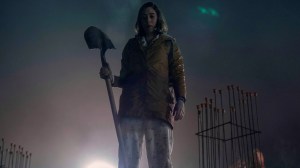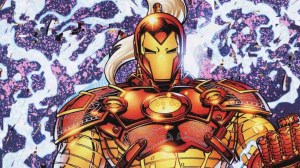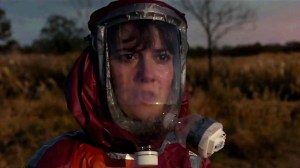Writer/director Dan Gilroy’s latest film, Velvet Buzzsaw, delivers audiences both a supernatural horror film and a satire of the world of art criticism, and it mostly accomplishes what it sets out to do. As is the tradition for many of Netflix’s genre offerings, however, it plays it safe and stops short of delivering anything with a real bite.
Videos by ComicBook.com
In the film, Josephina (Zawe Ashton) is struggling with her job at an art gallery when her neighbor dies, leading her to discover dozens of his impressive pieces. While her art critic friend Morf (Jake Gyllenhaal) demands exclusive access to the pieces to write a book, her boss Rhodora (Rene Russo) begins scheming ways to make as much off of the unknown artist’s work as possible. As various members of the Los Angeles art scene who have direct access to the pieces begin to mysteriously die, Josephina, Morf, and Rhodora’s plans, and lives, are put at risk as they attempt to discover the fatal effects the art has on admirers.

Gilroy has his work cut out for him with this project, as he is not only presenting the world with a piece of art, but also uses that art to attempt to mock those who dissect art. In that regard, it’s difficult to detail the effectiveness of the overall product, as the blending of these tones compete with one another throughout the entire film.
As a straightforward horror film, the film is hokey, yet manages to pull off a handful of effective sequences. Were Gilroy attempt to pitch the film to you personally as, “paintings mysteriously kill people attempting to profit off of it,” you’d think he was describing the storyline of a Goosebumps novel. However, adding the caveat that this story would be told by performers like Gyllenhaal, Russo, Toni Collette, and John Malkovich, you’d likely be much more interested, and it’s this cast that helps elevate the campy narrative. The horror sequences are fewer and further between than the biting comments about critics, but the performances and staging of these sequences do create a haunting impact on the viewer.
As a satire on the art world, the film absolutely holds a mirror up to those who feel as though their interpretation of art is just as important as the art itself. Virtually every word out of Morf’s mouth makes you cringe, not only because of how self-righteous the comments are, but also because it’s entirely possible you’ve heard someone say such things without a single hint of irony. Had Gilroy gone all-in on these elements, we could have gotten a Christopher Guest-level parody of the art scene, whereas instead, just as the comedy builds steam, the horror sequences pop up to shift the film’s tone back towards terror.
Gilroy’s directorial debut, Nightcrawler, became one of the most acclaimed movies of 2014, and featured one of the best performances of Gyllenhaal’s career. His next film, Roman J. Israel, Esq., didn’t connect as strongly with critics, leading to speculation that the filmmaker was a one-hit directorial wonder. Seeing the filmmaker’s depictions of critics in Velvet Buzzsaw make you wonder if the whole endeavor was merely an attempt to mock those who don’t love his work, making us wish he had broken up his ideas into two different films, as the comedy and the horror both work well while also prohibiting the narrative from being as effective as they could be. They’re two great tastes, but they don’t really taste great together here.

In most cases, artists present a viewer with their work, whether it be a painting, a film, or a song, and allow the work to speak for itself without having to provide context. The work of an art critic, typically, is to offer an observer context not only within the history of the medium, but also within culture, hopefully to enable the observer to digest what they’re experiencing as more than a casual witness. While critics Gene Siskel and Roger Ebert and their insight into cinema undeniably changed the ways in which audiences viewed films, they also instilled the idea of a binary “thumbs up, thumbs down” approach to engaging with art. In the decades since their rise to fame, determining whether art is good or bad and not allowing anything to exist in between, one could argue that critics have gained an air of audacity, with many believing they get to determine a piece of art’s worth instead of allowing an observer to decide.
The collapse of nuance in the age of social media and the misinterpretation of “criticism” being shouting your opinion as loudly as you can to convince yourself that it is an objective truth as opposed to a subjective opinion, in addition to sites like Rotten Tomatoes compiling long-form examinations of film into a label of “Fresh” or “Rotten,” has made criticism an understandably easy target. In that regard, many of Gilroy’s barbs about the scene feels like he’s punching down and taking obvious choices by delivering such pretentious caricatures and putting them through the wringer for his own therapeutic pleasure.
On the other hand, even the casual fan of any form of art has been “haunted” by something they’ve watched or heard, with the film playing on the psychological impact art can have on someone. Luckily, many of us aren’t literally followed by the disturbing feelings that are conjured when seeing something that frightens us, but Velvet Buzzsaw doesn’t limit itself just to art and can represent feelings of guilt we have over wronging someone who isn’t afforded the opportunity to defend themselves.
Both taken at face value and as an exploration of determining the worth of art and its impact on an individual, Velvet Buzzsaw‘s cast sells the hokey premise to deliver both laughs and scares, yet the overall experience puts these themes at odds with one another, stifling the product from the potential Gilroy has to deliver terror and derision.
Rating: 4 out of 5
Velvet Buzzsaw lands on Netflix this Friday, February 1st








